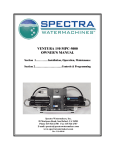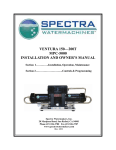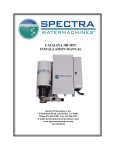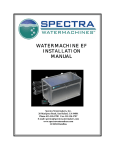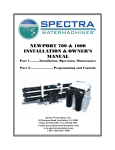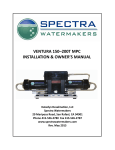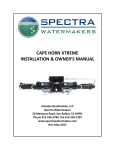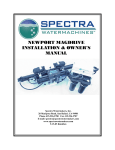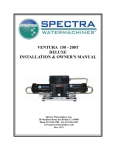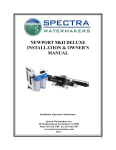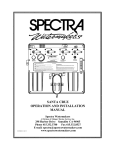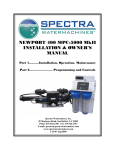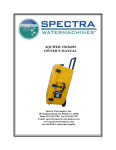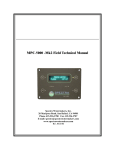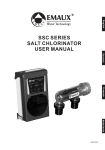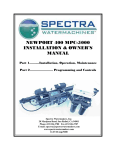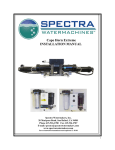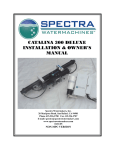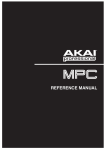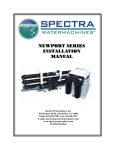Download VENTURA 150 MPC OWNER`S MANUAL
Transcript
VENTURA 150 MPC OWNER’S MANUAL Spectra Watermakers, Inc. 20 Mariposa Road, San Rafael, CA 94901 Phone 415-526-2780 Fax 415-526-2787 E-mail: [email protected] www.spectrawatermakers.com Rev. 09-27-05 2 Table of Contents Installation Page Number Introduction..........................................................................................................................5 Getting Started .....................................................................................................................6 Installation Basics ................................................................................................................7 Ventura Plumbing Schematic ..............................................................................................8 Feed Pump Relocation .........................................................................................................9 Product Water plumbing ....................................................................................................10 Tube Fitting Assembly Procedures....................................................................................11 Wiring ................................................................................................................................14 MPC Tank Switch Wiring and operation……………………………………………….. 16 Z Brane Installation ...........................................................................................................43 Operation New Systems Start Up and Testing................................................................................... 17 Dry Testing........................................................................................................................ 21 Normal Start Up Using the Auto Run ............................................................................... 23 Manual Operation.............................................................................................................. 24 Maintenance ...................................................................................................................... 27 Service & Maintenance Salinity Probe Calibration ................................................................................................. 21 Long Term Storage Procedures......................................................................................... 25 Winterizing........................................................................................................................ 27 Maintenance ...................................................................................................................... 28 Membrane Cleaning .......................................................................................................... 29 Suggested Spares............................................................................................................... 31 Troubleshooting Procedures, Service Bulletins ................................................................ 33 Part Numbers .................................................................................................................... 46 3 4 Introduction to the Ventura 150 MPC The Ventura represents the finest watermaker for small and midsized yachts available today. The Spectra Clark Pump is matched to a 21” high rejection membrane. Properly installed and maintained it will supply years of reliable service. The MPC-3000 control provides the ultimate in operational convenience and reliability. Note that prudent operation is required with any marine equipment. Always maintain enough reserve water to get safely into your next port. The Spectra High Pressure Intensifier, known as the Clark Pump, was introduced in 1997 and has continually improved since. It holds a lifetime warranty for the original purchaser! It is built of modern non-corroding composites. Front View Pressure relief valve Quick disconnect fitting to facilitate maintenance. Double rubber mounts to absorb vibration Rear view The Clark Pump membrane module. Pre-mounted and plumbed together as a single unit. Saves time and adds reliability. Ventura feed pump inlet module. Includes the feed pump, cooling fan, charcoal filter for the flushing system, manual flush valve, service valve and service port . Compact and streamlined plumbing. Feed pump may be removed and relocated if necessary. Cooling fan is included for long life. 5 Getting Started Unpack the system and inspect it to make sure that it has not been damaged in shipment. Refer to the shipping list for your system to make sure you have received all of the components listed. Do not discard any packaging until you have found and identified all of the parts. The small installation parts are listed on the kit list. Warning! We will not be held responsible for shortages and/or freight damage that are not reported within thirty days of the ship date. Study the system plumbing and wiring diagrams before beginning your installation. This will assist you in understanding the function of each component. Layout the system. Before starting the installation, identify the location where each module and component will be placed. Insure that there is proper clearance around the components for removal of filters and system service. Also check to make sure you have adequate tubing and hose before starting so additional parts may be ordered. Ventura MPC Shipping List • • • • • • • • • • • • • High Pressure Clark Pump and reverse osmosis membrane module. Feed pump inlet module with automatic fresh water flush system. Accumulator tank Seawater strainer MPC 3000 control with harnesses MPC 3000 display panel. Dual filter assembly with pressure sensors Installation Fittings Kit Service Hose kit 5/8” Hose (25’) 2 ea 1/4 product tubing (25’) Filter wrench Teflon pipe tape 6 Installation Basics • • • • • Thruhull Not Supplied. Read the directions! Avoid tight hose bends and excessive runs Use heavy gauge wire Install feed pump as low as possible Use a dedicated thruhull with scoop type strainer Flow Thru-hulls It is mandatory that a dedicated 1/2” to 3/4” forward facing scoop type intake thru-hull and seacock be installed. Install the intake for the system close to the middle and as far below the water line as possible. Thru-hulls in the bow area are susceptible to air intake in rough conditions. Sharing a thru-hull with another system is not acceptable and will void the warranty. Sharing a thru-hull can introduce unforeseen problems such as intermittent flow restriction, air bubbles, and contaminates. For racing boats and high speed power boats above 15 knots a retractable snorkel-type thru-hull fitting is preferred to be able to pick up water away from the hull. Do not install the intake close to or downstream of a head discharge. Install as far below the waterline and as close to center line as possible to avoid contamination and air induction. The brine discharge thru-hull should be mounted above the waterline, in or just above the boot stripe to minimize water lift. Double clamp all hose connections below the waterline. Pipe Fitting Instruction Plastic to plastic fittings should have 3 to 4 wraps of Teflon tape and will thread almost all the way in. Avoid getting dirt or debris into the piping or hoses during assembly. A small bit of debris can stop the system! Avoid getting tape over the end of fittings that might get into the system. To insure this does not happen, leave the very first thread uncoated. Avoid restrictions or long runs on the entire inlet side of the plumbing from the thru hull to the main feed pump module. Prevent tight bends and excessive elbows. Any restrictions will hamper system performance. Secure the piping away from moving objects such as engine belts and hatches. Prevent chafe on the tubing as required. Test and inspect all piping and hose clamps after several hours of operation. Wiring • • Pay attention to wire size or system performance will be impaired Perform wiring to UL, ABYC, CE or applicable standards 7 Ventura 150 MPC Plumbing Brine Discharge thru hull place above waterline or tee brine into another visible drain. Plastic fittings should have 3-4 wraps of Teflon tape and will thread almost all the way in. Leave the first pipe thread uncoated. Avoid getting dirt or debris in the system during assembly. Avoid tight bends and elbows. Secure piping away from moving objects and protect from chafe. Accumulator, Factory pre-charged. Install so that gauge is visible. Spectra Clark Pump. Mount in a cool location. May be oriented in any position and can be well above waterline. Leave access to the pressure relief valve. Do not mount over electrical equipment. Use supplied spacers and washers for the vibration mounts. 20 and 5 micron filters. Do not mount over electrical equipment. Leave clearance underneath for filter change Red In Green Out Fresh water flush inlet to charcoal filter. Plumb to pressure side of fresh water system. Sea Strainer, Mount with Quick Block Inlet pump module. Mount vertically as low as practical, no more than 4’ (1.1 M) above waterline and do not mount over electrical equipment. Leave clearance below for filter change. 1/2” or 3/4” scoop strainer thru-hull and seacock for watermaker only. Mount low, in a clear flow and away from head discharge. Thru-hull is owner supplied. Water Flow 8 Feed Pump Relocation If you do not have adequate space to install the feed pump inlet module it is possible to remove and relocate the feed pump. Before you install the module, disconnect the hose that connects the feed pump to the module plumbing. Remove the cooling fan and the heat sink from the pump. Both are friction fits with no fasteners. Remove the 4 machine screws holding the pump to the module. Cooling fan Machine Screws Heat sink With the pump on a flat surface. Remove the three screws that hold the pump head on. See Fig1 Re-orient the pump head 120 degrees. See Fig2 Reinstall the screws and tighten firmly. See Fig3 Now the feed pump may be installed where you wish. Do not install with the pump head over the motor incase of leaks. Wire size may have to be increased if wire runs are longer. Fig 1 Fig 2 Fig 3 9 Product Water Plumbing Product water tubing is 1/4”(6mm) on the Ventura 150 models. See the Parker tube fitting assembly diagram next page. Product water is pre-plumbed from the membrane into the electric diversion valve. The diversion valve will reject product water into the overboard brine stream until good quality is measured by the MPC-3000 control. Product water is then diverted into the fresh water tank. Product to tank. Route the product water into the top of the tank, or a tee in the water tank fill hose. DO NOT! feed into a vent line, a manifold or the bottom of the tank. Make sure that there is no restriction in this piping. Accepted Product Water Outlet Automatic Valve Check Valve Rejected product outlet Product from membrane RotoFlow Meter Salinity Probe Product Diversion Valve Manifold 10 Product Tube Fitting Assembly Body O-ring Spacer Grab Ring Nut Step 1: Tubing Dissemble fitting components 1/2" max Step 2: Install the Nut first then use the bevelled side of the Spacer to push the Grab Ring onto the tube no more than 1/2". Slip the O-ring over the tube to hold the Spacer in place. If the Grab Ring is pushed too far, trim back the tube so about 1/4" of tube extends past the O-ring. Step 3: Gently fit the tube into the body and loosely thread on the nut. Step 4: Push the tube into the body until it bottoms out then hand tighten the nut. DO NOT OVER TIGHTEN! 1/4" Tube Fitting Assembly 11 Membrane Pressure Vessel Relocation Use ONLY Dayco Imperial Nylo-Seal 88-NSR-1/2 tubing for high pressure connections. Pay attention to the direction and flow path of the tubing before disassembly. Make sure that you reinstall the tubing in the same manner. Rotate the 90 degree high pressure tube fittings on the Clark Pump for ideal tube runs. The high pressure fittings are typically preinstalled at the factory. These fittings seal with an O-ring and require no Teflon tape or pipe dope. Loosen the backing nut, rotate the fitting, and reseat the backing nut. Follow the high pressure tube connection instructions on the next page. Connect the tubes to one of the components, secure the tube runs, and then trim and connect to the other component. A 90 degree bend in a tube is better than a 90 degree fitting. A tube, when mounted, should have at least one gentle bend to allow for expansion. Do not connect a tube straight between hard mounted fittings. When connecting the tubes to their components, be sure to hold the fitting body with a wrench during the final tightening. Of special note are the stainless steel tube fittings on the membrane housing which seal with an O-ring and should be seated all the way in, but need only to be snug, not tight as with tapered threads. Hold the fitting with a wrench while installing the tube. The fittings on the Clark pump have an O-ring seal and can be re-oriented by backing out the O-ring stop nut. Rotate the fitting to align with the tube and tighten the nut just past hand tight. Do not over tighten! 12 Spectra High Pressure Tube Fitting Assembly Use ONLY Dayco Imperial Nylo-Seal 88-NSR-1/2 tubing for high pressure connections. Carefully fit and measure the tubing before cutting with a sharp razor knife or hose cutter and remove any burrs. Minimum tubing bend radius is 6”. Route tubing away from excessive heat sources and secure from vibration and chafe. Have at least one shallow bend in the tube assembly after it is installed. Refer to figure 1. If a fitting has been dissembled, reassemble as illustrated. The notch on the ferrule must engage the inside of the nut properly for the nut to seat down fully. Once the tube is inserted the ferrule and nut will naturally align. Refer to figure 2. Insert tube fully into the fitting, it should go in 0.9”. Tighten the nut finger tight while moving the tube around to prevent binding. One thread should be showing under the nut. Secure the tube so it won’t back out when tightening. Refer to figure 3. Use 13/16” wrench to hold a straight body fitting or a 3/4” wrench for a 90º body, and a 7/8” wrench for the nut. Hold the body, recheck the tube insertion, then tighten the nut 1-1/4 turns. Use the index mark on the nut as a guide. The threads should be completely covered by the nut. Make sure these fittings are tight on initial assembly or they will fail! The correct torque is specification is 85 foot pounds Index mark Straight thread Straight or 90 deg. 3/8" pipe thread Figure 1. Nut Ferrule Body Nut finger tight with 1 thread showing Cut tube square Figure 2. Black high pressure tubing Tighten 1-2/3 turns (10 flats of the nut) with a7/8" wrench after finger tight. Use index mark as guide No threads showing Figure 3. Insert tube 0.9" until it stops IMPORTANT! Hold fitting body with 13/16" a wrench when tightening 13 MPC-3000 Wiring Mount control on a vertical surface with the wire grommets down, central to the other system components. Make sure the cables will reach all of the modules to avoid splices. Warning! Do not connect the main power feed until all connections are made. Filter Sensor harness 6’ (2M) Control cable 50’ (15.2M) Protect connector while routing through the vessel. MPC-3000 display. Mount in dry central location. Only connect the MPC “plug in” cable. Fresh water flush feed 15’ (4.5M) Splice to flush valve. Heat connectors to shrink. Pump feed 4’(1.2M) may be extended as required. Count additional length in wire sizing. Wire fan in parallel. Main power feed. Install cover after terminating wires. Use a 15 amp breaker or fuse Clark Pump harness, RotoFlow meter, salinity probe, and diversion valve feed 15’ (4.5M). See next page. Wire Size Guide for Ventura 150 12V Protect with 15 Amp Fuse or Circuit Breaker # 10 Gauge (6mm) to 15 feet (4.5M) # 8 Gauge (10 mm) to 25 feet (7.5M) Total length for a pair of wires! #6 Gauge (16mm) to 35 feet (10.6M) Wire Size Guide for the Ventura 150 24V Protect with 7 Amp Fuse or Circuit Breaker #12 Gauge(4mm) to 10 feet (3M) #10 Gauge (6mm) to 25 feet (7.6M) #8 Gauge (10mm) to 35 feet (10.6M) 14 Clark Pump Harness Salinity Probe Roto Flow meter. Diversion Valve. To Roto Flow Meter To Diversion Valve To Salinity Probe The RotoFlow meter measures product flow. It is supplied with a three pin plug-in connector. Plug it in to the RotoFlow cable and seal the connection with the supplied heat shrink tubing. The salinity probe uses a telephone style jack and plug. Plug it in and slide the black plastic boot over the sensor to waterproof the connection. The diversion valve cable has two conductors. There is no polarity. Crimp the supplied heat shrink butt connectors to the diversion valve leads and heat them to seal. 15 Tank Switch Installation and Operation: There are two sets of terminals on the MPC-3000 PCB that can be used in four different configurations to automatically start and stop the watermaker, or to automatically stop the watermaker when the tank(s) are full without the auto start feature. These terminals are on the green ten pin connector and are labeled “Float Switch 1” and “Float Switch 2.” Float Switch 1 is the tank full switch and Float Switch 2 is the tank empty switch. If the unit is wired for both Autostart and Autostop, it can be put into AutoFill Mode by pushing and holding the Auto Run switch on the MPC-3000 display. In this mode the watermaker will start whenever the water level drops below the tank empty switch, so that it is open (not conducting electricity). When the tank fills up and both the tank full switch and the tank empty switch have remained closed for two minutes, the watermaker will shut down and flush itself. The watermaker will start back up when the water level drops below the tank empty switch and it remains open for 2 minutes. This configuration allows for completely automatic operation. If the watermaker does not need to start up within five days it will automatically do a fresh water flush. AutoFill mode can be ended by pushing the stop button or the Autoflush button. If the watermaker is in Autorun mode it can be put into Autofill mode without stopping it by holding down the Autorun button. If the owner prefers to install the automatic shutoff feature without the automatic start up option, only the tank full switch is used. A jumper must be placed between the tank empty terminals (Float Switch 2) in place of the tank empty switch, because the watermaker will only shut down if both sets of terminals are closed. To use this mode the watermaker must be started up with the Stop/Start button or the Autorun button. After the unit starts up, then press and hold the Autorun button until the display reads “Auto Fill Mode”. The watermaker will fill the tank and automatically enter Autoflush mode. It is possible to use the autofill feature with 2 tanks. A double throw electrical switch must be installed in a convenient location. If only the single tank full switch is installed in each tank, connect the wire from Float Switch 1 terminal “1” to the common on the switch and run separate wires from the switch to each tank switch. The second wires can both be run to the Float Switch 1 terminal 2. If you are using two switches in each tank, you will need a double pole double throw switch. 16 Ventura MPC New System Start-Up and Testing Avoid running the Ventura system if the vessel is in contaminated water, such as in a harbor or canal. The system should be fully tested before leaving port. If the location or weather prevents proper testing refer to the section “Dry Testing.” Warning! Damage may occur if the purge sequence is bypassed and the membrane is pressurized with storage chemical in it. First check that: • • • • • Thru-hull inlet valve is open and the brine discharge valve is open. All of your hose connections are tight. The green tag with the spacer under the pressre relief valve has been removed. The pressure relief valve is open 1/2 turn. The switch on the MPC control box is set to the“Auto” position. Remove Tag and Washer! Power up the system by turning on the circuit breaker. A message on the display will read Open 1/2 Turn when Purging Chemicals! Push the “Auto Run” Button. The feed pump will start and the message “Purging Storage Solution” will appear. 17 The system will go into a start mode and the feed pump will start shortly after. The system should prime within 60-90 seconds. Check the strainer and the brine discharge for water flow. There should be few bubbles anywhere in the intake hoses and the feed pump should sound smooth after priming. After confirming that the system is primed, inspect for leaks. Note: The reject light will be on whenever the product water is being rejected or not being made. When the product water is below 750 PPM the green (Good) light will show that water is going to the tank. Note: You can bypass the purge sequence and initiate a normal start at any time by Pressing both “Auto Run” and “Stop” simultaneously. This will bypass the purge sequence and enable a normal start. If you must stop the purge sequence for any reason, the control will default back to the beginning of the purging mode to protect your system. Do not bypass the purge mode unless you are sure that the chemicals are purged from the system or you will permanently damage the membrane. 1. After the purge sequence, the control will alarm with the message “Close pressure relief valve”. Close the valve and proceed by pressing “Auto Run.” 2. The system is now running under pressure and making water. The display will read “purging product water.” This mode dumps the product water overboard for ten minutes in case there is any residual chemicals in the membrane. Carefully inspect for leaks over the entire system! Shut down the system and repair any leaks you find. 3. The system is now in the operational mode. You may start and run your system as you desire. You will not have to go through the purging mode unless you “de-power” the system. If you do, you can bypass the purging mode by pushing “Stop” and “Auto Run” buttons at the same time. It is best to use the “Auto Run” button which defaults to the automatic fresh water rinse. If you shut down the system from the “Stop” button then use the “Auto Store” button to effect a fresh water flush cycle. 4. Check that the system is operating within its normal parameters. Compare with the chart on the next page. 18 MPC Display Modes Scroll through the modes with the alarm display key. Product The Ventura will produce 6- 6.5 GPH (26-27 LPH) Salinity This may not show any lit bars on a new system. Each square represents 100 ppm. System rejects water higher than 750 PPM. LED lights (Reject, Good) indicate product mode. Feed Water Pressure range 60-70 PSI (4.2-5 BAR) Filter Condition When filters become partially clogged the MPC-3000 will alarm “Service Prefilters”. If the filters become fully clogged (all squares highlighted) the unit will shut off automatically. 19 Ventura MPC Dry Testing With Artificial Ocean If it is not possible to test run the system with the boat in the water, testing may be accomplished with an artificial ocean. Purchase enough aquarium salt to make 5 gallons (20 liters) of salt water. Make sure that the domestic water system is powered up and that there is water in the tank. Confirm that the charcoal filter is installed in the fresh water flush module and that the domestic water line had been installed and all valves are open. 1. Open Pressure Relief Valve on the Clark Pump. Remove the green tag and spacer! 2. Close the yellow service valve on the inlet module. This will be the center location. 3. Power up the control. Bypass the purge mode by pushing “Auto Run” and “Stop” simultaneously. 4. Push the “Auto Store” button and allow it to run a flush cycle. Do this five times to purge the storage chemicals. 5. Hook up your inlet and brine discharge service hoses per the photo and route them into the 5 gallon (20 liter) container. Turn your product sample valve, if installed, to the sample position. If no sampling valve is installed, temporarily route the product to tank tube into the bucket. 6. Push the “Auto Store” button and fill the bucket with fresh water from the brine discharge. Stop the system when it is full. 7. Rotate the yellow service valve to the service position. 8. Mix the salt to the proper proportion or use an aquarium hydrometer to adjust the salinity level. 9. Push the “Auto Run” button, allow the system to prime and then close the pressure relief valve. The system should build pressure and after several minutes start making water. 10. Run the system under pressure and check for proper operation and leaks. After testing the system, stop and replace the brine discharge hose. Restart and drain the bucket. You can now store the system by using the above procedure for adding fresh water to the bucket and pickling the system, or using the “Auto Store” system. Valve in closed position Valve in service position Inlet service hose connected Connecting the brine discharge service hose 20 Salinity Probe Calibration Salinity is a measurement of total dissolved solids in liquid (TDS); these solids will conduct electricity to varying degrees. A special probe is used, with two electrical contacts in it, to determine the resistance to the flow of electricity in the liquid. In Spectra Watermakers’ systems, the salinity probe is located just before the diversion valve, at the output of the membrane. This way the salinity level of the product water can be evaluated before deciding to either reject the water or accept it and divert it into the holding tank. The salinity level in PPM can be seen either through the salinity meter in the software, or a jumper can be added to the MPC board in the “Calibrate” position, so that PPM can then be seen on the display (rather than a bar graph). After adding the jumper, it may be necessary to cycle through the different displays until the display reads “Salinity.” Procedure: 1. Locate the calibrate jumper location on the MPC-3000 board. Jump the terminals. 2. Start the system, and after the salinity stabilizes, test the product water with a calibrated hand held tester. 3. Locate the MPC calibration trimmer potentiometer on the board below the salinity probe jack. Adjust until the display PPM matches the PPM reading from the hand held salinity monitor. Turning the trim pot clockwise will lower the salinity reading, and counter-clockwise will raise it. 4. Shut the system down and disconnect the jumper on the MPC board. If a hand held meter is not available you can remove the probe and dip it into a known calibrated solution. 21 Ventura MPC Operation Normal operation If the system has been pickled or stored, use the “New System Startup” procedure. 1. Check to see that the inlet seacock is open. 2. Push the “Auto Run” one or more times. The machine will run for one hour for each time the button is pushed, then shut off and automatically do a fresh water flush. If you receive a “System Stalled” error code, there is no flow in the system. Open the pressure relief valve on the Clark Pump and bleed the air out of the feed pump. 3. Run the system until you have filled your tank or have made enough to meet your requirements for several days. 4. When the unit shuts down it will enter the “Auto Store” mode, which will flush the unit every five days unless you run it to make water, the unit is de-powered, or the “Stop” button is pressed. 5. You may stop the system at any time with the “Stop” button, but if you do it will not flush itself or go into “Auto Flush” mode. You may now leave the system unattended for up to five days without further attention We recommend operating the system for longer periods and effecting a fresh water flush rather than running the machine every day and not flushing the system. Remember that you need to run the system almost a half hour to make the flushing water. You may notice that the system output is higher while charging your batteries as the machine is voltage sensitive. Storage mode. The timer counts down in hours until the next flush cycle. Warning! Understanding automatic fresh water flush system is essential for it to be effective. 1. Make sure that the system has continuous power. Shutting down power will reset control. 2. Make sure that the potable water system is “on” and that there is adequate water in the tank for the extended period. 22 Automatic Fresh Water Flush Cycle Warning! Proper understanding of the Spectra flush system and the vessel’s fresh water system configuration is mandatory for extended automatic flush cycles. The flush cycle must not be allowed to drain all the fresh water from the vessel or damage to the vessel’s systems may occur. • Make sure there is enough water in the fresh water supply system to supply the watermaker for more than the expected time of operation in the “re-flush every 5 days” mode. The Ventura 150 requires 4 gallons (16 liters) every 5 days. • Make sure that the pressure water supply is on and will stay on during the flush mode (if this is not possible contact your certified dealer). • Make sure that the pressure relief valve is closed. It should be closed if the system was just used to make water. The auto flush may not operate if the valve is open. • The power for the system must remain on during the auto flush mode. Turning off the power will disable the auto flush function and damage may occur. • Pressing the “Auto Store” button will engage a flush and then the 5 day flush cycle. The flush pump starts and the flush water solenoid opens for 5-7 minutes and then shuts down. The display reads “Fresh Water Flush” with a countdown timer and then will read “Flush Timer Interval” and the countdown timer will reflect the number of hours until the next flush. • Pressing and holding the Auto Store button for 3 seconds will engage a one-time flush. The system flushes as described above but will not re-flush every 5 days. Display will read “Fresh Water Flush” with a countdown timer, then the default display when finished. • Pressing the “Stop” button will cancel the auto flush mode. 23 Manual Operation • • • • • In the event of an MPC control failure, the system may be operated manually using the switch on the feed pump module. For manual start up, set the switch to “Manual”. Shut the unit down if the Clark Pump does not cycle. In manual operation, the salinity control is inoperative and the diversion valve will not operate. Instead, product water must be taken directly from the membrane product water outlet. The automatic safety controls are disabled in manual mode. Bypass the diversion valve as follows: • Disconnect the 1/4 inch tube “A” that runs between the membrane product outlet and the RotoFlow meter at the membrane outlet fitting. Product water will run out of the fitting. • Taste the product water before sending it to a tank. Always discard the product water for the first few minutes of operation. The initial product water from the system may not be potable. • Disconnect the product-to-tank tube from the diversion valve manifold outlet and connect it to the membrane product outlet fitting. To shut down manually, set the switch “Auto” . If the system is to be left idle for more than a day it should be given a fresh water flush. To manually flush, collect 3 gallons of product water in a bucket. Connect the service hose to the service connection on the pump module. Place the service valve in “SERVICE” position and start the feed pump with the manual switch. Run the feed pump until the bucket is empty and turn the service valve back to “RUN”. Diversion valve manifold outlet Tube “A” Tube to tank Membrane product outlet Tube “A” Tube to tank Manual Operation Automatic Operation 24 Long Term Storage Procedures Watermakers are best run continuously. When not in use, biological growth in the membrane is the leading cause of membrane fouling. A warm environment will cause more growth than a cold environment. The fresh water flush system will greatly reduce biological growth but may not stop it completely in certain conditions. If an optional “Zeta Guard” or Z-Brane water treatment system is installed in the system, then three to five day flushing intervals will maintain the system as long as fresh water is provided and the charcoal filter maintained. System Storage or “Pickling” If the system is to be left unused for more than five days, perform the following storage procedure. The procedure introduces a chemical compound into the system that prevents biological growth. This procedure requires de-chlorinated water which can be made with the charcoal filter. Charcoal filters last a maximum of 6 months once wetted. Spectra SC-1 a special storage compound used by the US Navy. It is formulated to be compatible with the modern engineering plastics and composites in the Spectra pumps. Do not use any substitute except propylene Glycol, If you chose to use glycol follow the winterizing instructions. SC-1 Storage Compound has to be mixed at a ratio of 1 Spectra container to 3 gallons (12L) of fresh water to have the proper solution for short term storage (under two months use 1/2 of a container) Caution! Avoid contact with skin, eyes, or lungs with the storage chemical. 25 Ventura MPC Storage Procedure 1. Shut the service valve by moving it to the middle position. 2. Perform two fresh water flushes by pushing the “Auto Store” button . 3. Remove the cap on the service port on the feed pump module and install the service hose from your kit. Remove the quick disconnect fitting from the brine discharge outlet of the Clark Pump, and replace with a quick disconnect service hose from your service kit. Lead the hoses to a 5 gallon bucket or container. 4. Push the “Auto Store” button and run the feed pump until you have one gallon of fresh water in the bucket. Stop the system. 5. Mix 1 container of SC-1 storage compound with the water in the bucket. 6. Make sure the pressure relief valve on the Clark pump is OPEN (un-pressurized) by turning 1/2 turn counterclockwise 7. Place the service valve in “Service” position 8. Turn on the feed pump. You can use the manual switch on the MPC-3000 control box. Circulate the storage chemical in the system for approximately 10 minutes. Turn off the feed pump when finished. Clean Up Remove the quick disconnect from the Clark Pump brine discharge, and replace the original hose that leads to the thru-hull. You may at this point, if you choose, pump the bucket dry by using the feed pump switch. Stop when the bucket is empty. Turn the service valve 180° back to its original position, and remove the service hose. Close the seacock and drain and clean the strainer and any filters in the system. Reassemble dry. Service valve Off Service hose connected Service valve in service position Brine disconnect fitting 26 Winterizing 1. Close yellow service valve, push “Auto Store” to flush the system. 2. Connect the inlet service hose and the brine discharge service hose. Place them in the service container or bucket. 3. Push “Auto Store” and run until there is 1 gallon (4L) of fresh water in the bucket, then stop the system. 4. Reconnect the brine overboard hose to the Clark Pump 5. Turn the service valve to the “Service” position. 6. Pour 2 gallons (8L) of Propylene Glycol in the bucket. 7. Make sure that the pressure relief valve is OPEN (un-pressurized). 8. Turn on the feed pump with the manual switch on the MPC control box until antifreeze appears in the brine overboard hose. 9. Stop the pump. Reconnect the brine service hose. Start the pump and re-circulate the remaining antifreeze for a few minutes. 10. Close the seawater intake and the service valve. Drain the strainer and the hose leading to the inlet module. 11. Disconnect the product to tank tube and blow the water out of it with compressed air. Valve in off position Valve in service position Open the pressure relief valve Connecting brine discharge hose 27 Maintenance General Periodically inspect the entire system for leakage and chafe on the tubing and hoses. Repair any leaks you find as soon as practical. Some crystal formation around the Clark Pump blocks is normal. Wipe down any salt encrusted areas with a damp cloth. The Seawater Strainer The sea water strainer’s stainless steel element should be inspected, removed, and cleaned as needed. Be careful to ensure that the thru-hull is closed before disassembly and the gasket is in place before reassembly. When the system is put into storage, remove, rinse, and reassemble dry to impede corrosion. Check frequently during operation. The Prefilters • • • Service the pre-filters on a regular basis. The MPC will alarm when the filters reach a 5 PSI (.35 BAR) pressure drop. You may clean and reuse the filters at this level. If you continue to use the system until it stops at 10 PSI (.75 BAR) then the filters will have to be discarded. To service the filters, shut off the service valve, open the housing, and discard the old filters. Clean out the housing bowl and reassemble the housings with new 5 and 20 micron filter elements. Leave dry until next startup. Use only Spectra approved filters or you may void your warranty. The filters may be cleaned several times with a soft brush and water in a bucket. Occasionally, lightly lube the filter housing O-ring with silicone grease. Oil Water Separator (Optional) To install oil water separator capability remove the 20 micron filter from the dual filter housing and replace with the oil water separator element. The Charcoal Fresh Water Flush Filter • Replace the charcoal filter element at least every 6 months! This filter protects the membrane by removing chlorine from the fresh flush water. Use only a Spectra replacement! The Feed Pump and Clark Pump The feed pump and the Clark Pump require no routine maintenance except inspection for leaks. Tighten any hose clamps or fittings the show signs of leakage. The high pressure stainless steel fittings threaded into the Clark Pump have o-ring seals with a straight thread. These should never leak and should never be over tightened. If one of the tube nuts starts to leak it can be un-threaded, sealed with a bit of silicone grease or silicone seal, and, using two wrenches, tightened very tight. 28 The Membranes The membranes need to be cleaned only when operating pressures have risen 10% due to fouling, or when the product quality degrades. The leading cause of fouling is from biological growth that occurs when the system is left unused without flushing or pickling. Fouling from mineral scaling can happen during operation under certain sea water conditions, and from rust. Monitor the product salinity and feed pressure for higher than normal readings for the existing conditions. Other conditions can cause high pressure such as cold feed water or clogged filters. Low product flow is usually due to low voltage, damaged feed pump or Clark Pump. Look for all other causes before cleaning the membrane. Membrane life can be shortened by excessive cleaning. There are two types of cleaners: acid and alkaline. The acid cleaner (SC-3) will remove mineral scaling. The alkaline cleaner (SC-2) is used to remove biological by-products, oil, and dirt particles that get past the prefilters. If membrane performance is reduced and they have not been “pickled” recently, cleaning is recommended. The acid cleaner should be used first. If the problem persists after the acid cleaning, do the alkaline cleaning. If the membrane fails to respond to both cleanings, this is an indication of another problem with the system, or that it is time to replace the membrane. Contact Spectra Watermakers before removing a membrane. Membrane Cleaning For normal cleaning, the SC-3 Acid Cleaning Compound is used first, then the SC-2 Alkaline Cleaning Compound. If known bio-fouling is present, the SC-2 may be used first. Using hot water if possible, up to 120° (45C) is recommended as it greatly enhances the ability of the cleaners to do their jobs. If the history of the system is unknown or it has been left “unpickled” for an extended length of time and biological growth is present, it is recommended that the system be cleaned with SC-2, using an alternate source of unchlorinated fresh water before the system is run under pressure. A simple test can be performed to see if biological growth has occurred. Before running the system, remove the prefilters and examine their condition. If the housings are full of smelly discolored water, the system was not properly stored. Install clean prefilters if they were bad. Next, check the membrane. Detach the brine discharge hose and lead to a bucket. Open the pressure relief valve one turn, and manually run the system for 30 seconds. Examine the brine water. If it is discolored and smells bad, perform an SC-2 cleaning with an alternate source of unchlorinated water before running the system pressurized. If the brine is fairly clean, the system can be purged, run normally, and checked for performance. Clean the membranes only if performance is reduced. Heating the water is preferable. The cleaning solution throughout the system will heat as it circulates in and out of the pot. An alternative is to heat the one or two gallons of initial water to 120° on the main stove before mixing in the cleaner and circulating it into the system. Periodically stop and reheat the solution. Perform the cleaning procedures while the ship is in acceptable sea water for purging and testing, or follow the flushing, purging, and testing procedure given in the “Dry Testing with Artificial Ocean” instructions. 29 Spectra cleaning compound (SC-2 or SC-3) must be mixed with fresh water at a ratio of 1 container of compound to 3 gallons (12L) of unchlorinated water to have the proper solution. An average of two gallons (8L) of water is already present inside a Ventura 150 system . This water has to be figured into the mixture. A Ventura 150 system will use one container of compound. Cleaning Procedure: 1. Close the service valve and push “Auto Store” to effect a fresh water flush. 2. Connect your inlet service hose and the brine discharge service hose. Push “Auto Store” again and allow to run until there is 1 gallon (4L) of water in the bucket. Stop the system. 3. Turn the service valve to the service position. 4. Make sure that the pressure relief valve is open (un-pressurized). 5. Mix the cleaning chemical in the bucket. 6. Start the system with the manual switch on the MPC control box and circulate the chemical through the system for the required time. 7. Stop the pump, replace the brine discharge hose and start the pump until the bucket is empty. Stop the pump and rotate the service valve back to the run position. Restart the pump and run for 20 minutes to flush the chemicals out of the system. (DO NOT CLOSE the pressure relief valve!) 8. The system may now be restarted to make water, flushed or stored. . Service valve in off position Service hose connected Open the pressure relief valve! Connecting brine discharge hose 30 Suggested Spares Ventura MPC Short term cruising, weekends etc. A basic cruise kit B. This kit consists of three 5 micron filters, three 20 micron filters, and SC-1 storage chemicals. Cruising 2 to 6 months at a time. Two basic cruise kits, one replacement charcoal filter, and one replacement feed pump head. Longer than 6 months Additional filters, offshore cruising kit consisting of Clark Pump seals, O-rings, tools and membrane cleaning chemicals. One replacement strainer screen, O-ring for strainer screen, O-rings for filter housing, Part Number Spectra Watermakers recommended spare parts SC-1 STORAGE CHEMICAL SC-2 CLEANER SC-3 CLEANER BASIC CRUISE B OFFSHORE REBUILD KIT 5 MICRON FILTER 20 MICRON FILTER CHARCOAL FILTER 5” STRAINER SCREEN OIL/WATER FILTER FEED PUMP HEAD 5” STRAINER O-RING FILTER HOUSING O-RING OFF SHORE KIT 20” MEMBRANE SALINITY PROBE SALINITY PROBE CABLE list: KIT-CHEM-SC1 KIT-CHEM-SC2 KIT-CHEM-SC3 KIT-BCK-B KIT-OFFSH FT-FTC-5 FT-FTC-20 FT-FTC-CC FT-STN-5S FT-FTC-OW PL-PMP-SFPH SO-STN-5SS SO-FHS-10H KIT-OFFSH FT-MB-20 EL-MPC-SP EL-MPC-SSC15 31 Ventura MPC Troubleshooting Procedures SYMPTOMS PROBABLE CAUSE REMEDY Feed pump runs constantly, will not turn off Manual override switch in “on” position Turn off manual switch on control box Feed pump runs with loud noise - Intake blocked - Air in system - Check thru-hull valve - Check sea strainer for leaks - Check FWF module for leaks - Re-prime system (restart) No lights or display, system does not operate - Remote display not connected - No power to control box - Check display cable connections at back of display and at control box - Check and reset main DC supply breaker - Check for voltage (12 or 24vDC) at control box power input studs - Try manual bypass switches; if pumps run, then control or display is defective Pumps run intermittently, cycling on/off System operating in flush mode (DC models) Display activates, but pump will not run - loose or broken pump wire connection - bad pump relay - blown F3 or F5 fuse on MPC - tanks are full - Check wiring at terminal block inside MPC - Test power relay, replace - Replace fuse (mini automotive type ATM) - Check tanks– system cannot be started if tanks are full. diversion valve inoperative wiring fault. disconnected or broken product tubing diversion valve plunger - Check wiring at diversion valve and inside control box - Check product tubing - Disassemble and clean diversion valve plunger or replace valve (contact factory) high salinity of product water, causing system to reject water salinity probe out of calibration or defective, bad cable chlorine damage to membranes pressure relief valve open - Check for low feed pressure, close pressure relief valve - Check for leaks at high pressure hoses - Test product water with handheld tester– if over 500ppm for 1 hour, contact factory System runs, no product water delivered to water tanks, GPH bar graph shows OK, “Good” LED activated - System runs, no product water delivered to water tanks, GPH bar graph shows OK, “reject” LED activated - - - - - System will time out, or manually stop with the Start/ Stop button Close Valve 32 Ventura MPC Troubleshooting Procedures Error Messages SYMPTOMS “System stalled” (“system stalled” may alarm when using the control panel to run system for servicing with the pressure relief valve open– use manual override switch instead) PROBABLE CAUSE - pressure relief valve open intake thru-hull closed airlocked system no signal from stroke sensor or RotoFlow meter REMEDY - Close pressure relief valve - Check thru-hull - Verify stroke sensor fully inserted in pump - Check stroke sensor wiring at control box - Replace stroke sensor “High Pressure” - blocked brine discharge - fouled membrane - Check brine discharge - Clean membrane “Voltage Too High” “Voltage Too Low” - battery voltage too high or low - loose wires or poor connections - Charge batteries - Check charging voltage - Check power connections “Re-starting” - no signal from stroke sensor at startup. System stalled - See remedy above for “system stalled” “Check Fuse” (followed by fuse number) - blown fuse at circuit board - Replace fuse (mini automotive type ATM) - Look for cause “Service Prefilter” - clogged filters - loose or defective pressure sensor wires - Install new filters - Check sensor wiring “Ck Sea Strainer” - clogged strainer - dirty 50 Micron prefilter - Seacock closed - Clean strainer screen; change 50 micron filter; check through-hull and intake hoses “Salinity High” - high product water salinity - chlorine damage to membranes - defective salinity probe or cable, cable disconnected - Check for low feed pressure - Check for leaks at high pressure hoses - Remove and clean probe contacts check calibration. - Check cable connections - Clean membrane 33 ACCUMULATOR PRESSURE All Spectra Watermakers, except the Newport 700 and 1000 series, are supplied with a pressure accumulator tank (part no. PL-ACC-TK) to be installed in the feed water line between the prefilters and the Clark Pump. In addition, the Catalina 300 and Newport 400 series also have an accumulator mounted inside the fresh water flush module. The purpose of the feed line accumulator is to reduce the spikes in the feed pressure caused by the cycling of the Clark pump. If the accumulator is not properly charged it can lead to problems with the ShurFlo pump pressure cutout switches. The accumulators have an air valve on top similar to those found on car tires. This allows the internal air bladder of the accumulator to be precharged. The accumulator should be pumped up to about 65psi (4.5bar) for best results. Add air using a tire pump or air compressor. You can experiment with the exact pressure that will give the best pulsation dampening on your installation. The purpose of the fresh water flush accumulator is to allow a steady flow of 1.5 gallons per minute of flush water through the charcoal filter. Because the feed pump on the 300 and 400 hundred series exceeds this maximum allowed flow rate, the controller turns it on and off, to reduce the overall flow rate. The accumulator gives the water flowing through the charcoal filter somewhere to go while the feed pump is cycled off. The flush water accumulator should be preloaded to 5 psi (.35bar). 9/27/04 34 OP-2 BAD SMELLING PRODUCT WATER The reverse osmosis membrane is permeable by many gases including hydrogen sulfide, the gas that causes rotten eggs to smell the way they do. If there are bad odors in the feed water they will go through the membrane and the product water will be affected. Usually the source of the odor is from the decay of planktonic creatures trapped in the sea strainer and prefilters. These tiny oxygen loving creatures soon suffocate and die inside the prefilter housings when the unit is shut down. Once all the available oxygen is consumed, anaerobic bacteria begin to grow, causing the odor. If a unit being used frequently begins to make smelly water, it will be the prefilters that are the source of the problem. This occurs in a week or two in cold climates, but in less than one night in very warm waters like the Sea of Cortes or the Red Sea. These bacteria can spread throughout the watermaker, and begin to grow on the membrane, causing poor water quality and high feed pressures. Filling the system with fresh water after every use greatly slows this process, allowing the automated Spectra units to operate with less frequent prefilter changes. Units operated for only an hour or so a day will probably need to have the filters changed due to odor before they are dirty enough to restrict water flow. Prefilters can be cleaned. We recommend that you have three sets in service, one in the unit, one set soaking overnight in a bucket of clean fresh or salt water and one set drying for the next use. After shutting down the unit, remove the used prefilters and install the dry set. Leave the housings full of air until the next use. On non-automated systems, open the pressure relief when starting if there is a lot of air in the system until the air is cleared out through the brine overboard. The filters will get just as clean when soaked in sea water, but dry much faster if soaked in fresh. Given gentle handling, prefilters can be reused many times. Bad smelling product water is usually caused by bad smelling feed water, but can also be caused by a fouled membrane if the membrane has been left unpickled. If the unit makes smelly but not salty water after a long idle period and the prefilters are new, the smell can be eliminated by running the unit unpressurized for an hour or so to flush the membrane. Odors in the product water can also be eliminated by adding a charcoal filter in the product water line. Spectra offers a product water filter kit (part no. KIT-FLT-CC). More on this subject is available on our website at www.spectrawatermakers.com. 8/17/04 35 OP-3 CHEMICALS 101 Spectra systems use four types of chemicals: SC-1, SC-2, SC-3, and propylene glycol antifreeze. NOTE: Never use any chemicals with the system pressurized! Always open the pressure relief valve 1/2 turn. Always purge a system containing chemicals for at least 20 minutes unpressurized before pressurizing and making water. The SC-1 is for storage only. It is no longer used as a cleaning chemical. To prepare the system for storage, first do a fresh water flush until the brine discharge is below 1000 ppm or does not taste salty. Mix one jar of SC-1 with 1 to 2 gallons of product or de-chlorinated fresh water in a bucket and circulate UNPRESSURIZED with the fresh water in the system for 10 minutes, then discard. The system should be re-pickled every six months in warm conditions, and every eight months in cooler conditions. The Spectra systems should be stored with propylene glycol if freezing could occur. This is the food grade antifreeze used to winterize RVs, boats and cabins. This works very well for storing in warm climates and is good for one year. See “Wintering or Pickling With Antifreeze” for instructions on this procedure. NOTE: Do not use metasodium bisulfate, the standard chemical used to store most watermakers. This chemical will damage the Clark pump and void the warranty. CLEANERS: Cleaning can be detrimental to the membrane and shorten its life. Avoid unnecessary cleaning. Avoid cleaning as a diagnostic tool. SC-2 is an alkaline cleaner used to remove light oil, grime and biological growth. It is most effective if heated to 120 oF On a boat this is not easy to do. If not heated, circulate for 2 hours and let set for several hours and re-circulate for one hour and discard. In most cases the water quality will increase in PPM after an SC-2 cleaning. After a few hours it should recover to near the PPM it produced before the cleaning. SC-3 is an acid cleaner used to remove mineral and scale deposits. This is used in the same way as the SC-2. In most cases this is used first, and if no results are achieved, proceed with the SC2. SC-3 will in most cases lower the product PPM and over all pressures. Scaling is a slow process that may take several months or years. SC-3 is less harmful to the membrane and will almost always improve the performance of an older membrane. 7/19/04 36 OP-4 FRESH WATER FLUSH The purpose of the fresh water flush is to replace the sea water in the watermaker with fresh water whenever the system is not operating. The “Auto Flush Mode” on the MPC 3000 changes the fresh water every five days if the system has been idle that long. The watermaker will last longer and operate better if it is always kept filled with fresh water between uses. Most spectra watermakers are equipped with a fresh water flush module. This module includes a 50 micron filter to filter out abrasive particles in the feed water that might damage the feed pump, a charcoal filter to remove any chlorine in the fresh water that might damage the membrane, an electrically operated valve and a check, or “one way”, valve. The electrically operated solenoid valve opens during the fresh water flush allowing the boats pressurized water system to supply water to the system. The check valve prevents the fresh water from going out backwards through the sea strainer and sea cock. The charcoal filter has a maximum flow rate of 1.5 gallons per minute (6lpm) so the feed pump is operated at a reduced speed on some models, or is cycled on and off on other models, to avoid exceeding this flow rate. If the ship’s water system is unable to provide flush water at the required flow rate, sea water will be drawn in to make up the difference. This will cause the flush water to be brackish, and ineffective in preserving the watermaker. At initial startup the fresh water flush system should be tested by taking a sample of the brine discharge water just as the flush cycle is ending. This water should not taste salty, and should read less than 1000 ppm on a digital tds meter. The flush cycle can also be tested by closing the sea cock during the flush cycle. If the MPC3000 display gives a CK SEA STRAINER alarm this means that the fresh water supply is insufficient. Because the pre-filters trap the plankton in the feed water they can be subject to “going anaerobic” or starting to smell like rotten eggs, as the trapped plankton decay. For this reason it is advisable to always put in clean elements if the unit is going to be left on Auto Flush Mode. In daily or regular use the fresh water flush after each shutdown will help prevent this problem, but in excessively warm or fertile waters the pre-filters will need regular attention. 7/26/04 37 PF-3 PREFILTERS– ShurFlo Up to four different filters are used on all Spectra Systems using ShurFlo feed pumps to ensure that no damaging foreign materials enter the system. There are 2 or 3 filters in the system to clean the feed water of abrasive materials while the system is in operation, and an additional filter to prevent the entrance of chlorine during fresh water flushing. During normal operation, the feed water is filtered in two stages. First it enters a fine mesh metal sea strainer. This protects the feed pump from damage due to foreign materials and larger sea creatures. After passing through the pump the feed water enters the filter housings containing 20 and 5 micron elements. These filters remove very fine particles which could damage the Clark Pump and shorten membrane life. Some units have only the 5 micron filter. Cleaning schedules will vary widely depending on how and where the system is used. If large amounts of feed water are run through the system in a relatively short period in biologically fertile near shore waters, the prefilters will plug up, the pressure drop across the filters will rise, production and quality will drop, and the system will sense plugged filters and give a “Service Prefilters” or “Check Strainer” alarm if so equipped. Plugged filters can be cleaned several times by soaking in a bucket, towing behind the boat at moderate speeds, or cleaning with a hose. When operated only an hour or two a day in inland or near shore waters, the trapped plankton will begin to decay in the filters long before the elements plug up, and the bacteria involved in the decay will cause a “rotten egg” smell in the product water. This decay will set in overnight in tropical waters, or after a week or two in high latitudes. If handled gently and changed regularly before they get too smelly, filters in this service can last through dozens of cleanings. In crystal clear blue water conditions the filters may need to be cleaned much less frequently. The charcoal filter used in the fresh water flush system will not plug up unless you have some incredibly dirty domestic water in your boat. About six months after installation the charcoal filter element will lose its effectiveness at removing any membrane-damaging chlorine which may be present in domestic water. Charcoal filter elements must be replaced every six months if there is ANY chance that chorine could be introduced into the flush water. To ensure that filter elements fit properly and remove chlorine effectively, they should be purchased at factory authorized dealers. Our element part number is FT-FTC-XX. The last two digits indicate the micron rating, e.g. FT-FTC-05 is for a 5 micron element. Charcoal elements are FT-FTC-CC. 06/03/04 38 SF-1 SHURFLO PUMP WON’T RUN If the pump has power to it (the fan runs), but the pump won’t run, the first thing to check is the pressure switch. The pressure switch, p/n EL-FP-PS, is located on the wet end of the pump and has two red wires plugged into it. Jump the two red wires together and see if the pump runs. You can safely run the system with the pressure switch jumped, just keep an eye on the pressure gauge and don’t let system pressure exceed 110 psi. Replace the switch when a spare is available. If the pump will not run with the pressure switch jumped then it is most likely a problem with the brushes or overheat protection switch inside the motor. The motor will come completely apart by removing the two screws on the end of the motor. Remove the rear cover and paper insulator. Pull out the plastic brush holder. The thermal switch is located on one of the brush leads. With an ohmmeter, check for continuity through the switch. If it is open, you can make temporary repairs by wiring around it, being careful that your new wiring doesn’t chafe on the moving parts, nor resist the springs that push the brushes on to the commutator. If any corrosion is apparent the brushes may be sticking. Once apart clean all the carbon dust from all the parts. Clean the commutator with light sand paper. Make sure to clean the small grooves on the commutator with a small sharp tool to remove the carbon in between the segments. Adjust the springs on the brush holders so the brushes slide smoothly in and out. If the bearings are rough and binding, remove the rubber dust cover and clean the best you can, grease them, and work it free by hand. Don't service the bearing unless absolutely necessary. Reassemble in reverse order. You can hold the carbon brushes back with papers clips inserted through the slots in the brush holder so they don't hang up on the bearing during assembly. Make sure the corrugated bearing shim doesn't push out, if it does, push it back into place. This will at least keep you going until the motor can be replaced if necessary. 6/03/04 39 SF-2 ADJUST SHURFLO PRESSURE SWITCH The ShurFlo feed pumps are equipped with a high pressure cut out switch (part no. EL-FPPS). This is the small black unit on the end of the wetted end of the pump head (part no. PLPMP-SFPH) where the two red wires connect. If the pressure switch is not properly adjusted the pump may cut out each time the Clark Pump cycles and the feed pressure spikes. When this happens, the production will drop and an unusual noise will be heard when operating with two pumps, but the system will function normally during one pump operation on either pump. The points in the switch will fail fairly quickly if set too low because of the constant arcing from cutting out each time the Clark pump shifts. For all systems except the Gulfstream, the feed pump pressure switches should be set to shut off at 125 psi (8.5 bar) as follows. On the very center of the switch is a small 5/64” allen screw. Run the system on pump one and close the brine discharge valve (1/2 way 90 deg) to block the flow. Watch the pressure gauge and adjust the pressure switch to shut off at 125 psi. Repeat for pump two. Turn the allen screw clockwise to increase the cut off set point. Gulfstream models could experience seal failures in the manifold if pressurized too high. For this reason, the pump should be removed from the system and the switch adjusted using a separate pressure gauge. If replacing a feed pump or pump head for a Gulfstream model arrange to preset the switch before installation. 8/05/04 40 HS LF-1 POOR PRODUCT QUALITY With any product water quality issue, you need to check the calibration of the salinity tester that you are using before proceeding. Membranes are not an exact science and two identical systems can have a different product quality result. World health standards deem water of up to 1000 PPM of total dissolved solids acceptable for drinking consumption. We consider any thing below 700 PPM acceptable but not ideal, and anything below 500 PPM excellent. Factors that could affect water quality are addressed below. LOW SYSTEM FLOW OR PRESSURE will equate to lower product quality (higher PPM). A 200-C system running at 70 psi will deliver product water in the 400- 500 PPM range, while the 380-C systems with twice the flow and operating at 100 psi into the same size membrane, will produce 200-300 PPM water. Ventura 150 systems, which have a higher feed to output pressure ratio (See MISC-4 nominal pressures), as well as a higher feed flow/membrane area ratio, will produce water in the 150-200 PPM range. These improvements in product quality come at the expense of energy efficiency. DAMAGE TO THE MEMBRANE by chlorine contamination. Flushing the system with chlorinated water will irreparably damage the membrane. Charcoal filters are used to absorb any chlorine which might be present in flush water. They must be of proper specification to be suitable. There is no test for chlorine damage except the process of elimination of other causes. DIRTY OR SCALED membranes. A dirty (foreign material), scaled (mineral deposits), or contaminated (bacterial growth) membrane can result in poor water quality and abnormal operating pressures. If operating pressures are above normal, then cleaning is indicated. If the system pressures are within operating normal range, cleaning may have little result. Cleaning is no better for a membrane than it is for your clothes. Avoid cleaning as a diagnostic tool. MECHANICAL LEAKAGE within the membrane pressure vessel. This is an unlikely but possible cause of poor water quality with old style Codeline pressure vessels (white) that we have used in the past. The Spectra pressure vessel has a double O-ring arrangement that includes a telltale hole between them so that any salt water leaking past an O-ring will drip into the boat and not go into the product water. If system flow (product plus brine) is 1.5 GPM or above on one pump, the membrane is clean, the product flows are consistent with the system flow and the water quality is still not acceptable, then replacement of the membrane is indicated. See “HS-LF2 Flow Check” for instructions on checking flow rates 7/6/14 41 HS LF-2 FLOW TEST/ SHURFLO Before the test, change all filters and clean the strainer. Make sure that there are no leaks. Check for air leaks, as air in the system will cause low production and erratic salinity. Look for air bubbles in the product flow meter, feed pump discharge hose, and brine overboard hose. Run the system and watch the pressures very closely. Make sure that on each shift everything is even from side to side. If the feed pressure to the Clark pump is different (asymmetrical) on one stroke than on the other this could be part of the problem. A difference of a few PSI is acceptable, but anything over that is an issue. If the pump is asymmetrical Clark pump repairs should be done before continuing with these tests. Ask for CP-5 Clark Pump Checkout instructions. If no asymmetry is noted, please do this test. NOTE: On Ventura 150 and 200 models with only one feed pump, disregard the instructions concerning “pump two” and “both” Make sure the ShurFlo overpressure cutout switches (part no. PL-PMP-SFPH) are set to 125 psi. With pump 1 running, close the brine service valve. The feed pressure should rise to 125 psi and the pump should shut off. Repeat with pump 2. If the pumps shut off at a lower pressure see “SF-2 Adjust ShurFlo Pressure Switch” bulletin. 1. Log the pressure on pump 1, pump 2, and both. Log the product GPH (LPH) at the same time. 2. Log the voltage at the feed pumps at the same time. Confirm at least 12.5 volts at the pumps. You may have to run the engine or battery charger. 3. Measure the total flow rate of the system. Run the system making water and divert BOTH the brine discharge AND product water into a bucket. Time how long it takes to make a given amount of water. Repeat with pump 2 and both pumps. In order to make good water, you need the proper amount of feed water flow. Each pump alone should produce 1.5 gallons per minute (5.7 lpm). Running on both pumps the flow should be 2.7 gpm (10 lpm). Compare the product flow to the total feed flow. Product flow should be 7% of total flow for a 150, and 9.5% of total flow for a 200 or 380 model. If product percentage is low, you may have an internal leak in the Clark pump. For every 1/10th of a gallon per minute of feed water flow loss, we will lose about 1/2 gallon per hour of product flow and the salinity will go up 100ppm. Low feed flow combined with low system pressures, (see “Misc-4: Nominal Pressures”), is most frequently due to worn ShurFlo pump heads (part no. PL-PMP-SFPH). 9/24/04 42 Z-BRANE OPERATION MANUAL Spectra Watermakers Inc. 20 Mariposa Rd., San Rafael, CA 94901 Phone 415-526-2780 Fax 415-526-2787 Email: [email protected] Http://www.spectrawatermakers.com Current manuals/Z-Brane 12/10/04 43 The Z-brane is a revolutionary product which incorporates the Z-Guard High Voltage Capacitive technology into the membrane pressure vessel. Always active, the Z-Brane creates an environment that is unfriendly to bio-film and bacteria. The Z technoalgy also assits in the prevention of scale formation on the membrane surfaces. The Z-Brane allows the system to be shut down or decommissioned for extended periods of time without chemicals or preservatives. The Z-Brane will not prevent freezing so that in cold climates Propylene Glycol is still required. The Z-Brane system is integral with the watermaker unit and only requires continuous 12Vor 24V DC power to be operative. The installation of the Z-Brane only consists of wiring the power supply to a continuous source The Z-brane power supply can tolerate voltages between 10V and 28V DC. Note: There is no reason to open the transformer enclosure. Do not service this unit without disconnecting the power source! There may be high voltage present. It is recommended that the Z-Brane be connected to a discreet continuous power source. The power must be on during the time that the system is operation and during the time the Z-Brane is used for membrane storage. If the power is obtained from the MPC then the MPC must be powered up at all times during storage. This may not be desirable. Fuse the power at the source with a 5 amp fuse or circuit breaker. Red is Positive (+) , Black is Ground (-) Z-Brane Power Harness 44 Operation During normal operation the Red LED should be on . Power needs to be supplied to the ZBrane unit at all times that you wish to have the biofouling and scale protection. We recommend that your watermaker be flushed after each use not only to protect the membrane but to prevent corrosion in the feed water system. To achieve full effectiveness thoroughly fresh water flush the watermaker several times before leaving the vessel. The Z-Brane may be de-powered if the system is stored with chemicals or winterized with Glycol. Power on LED High Voltage connector DO NOT DISCONNECT OR SPLICE ANY OF THE HIGH VOLTAGE WIRING! Contact the factory if modifications are required. 45 3/8 NPT Quick Disc. Body PL-QDC-BD3/8 Front View 5/8 Quick Disc. Hose Barb PL-QDC-HB5/8 1/2” High Pressure Tube PL-NLT-1/2HP Plate Bracket End Cap FM-PVB-PBE 3/4”NPT X 1/2” Hose Barb Elbow PL-HBE-3/4X1/2 1-Way Solenoid Valve 12V, 24V PL-SLN-1/4O12,24 Rear View Plate Bracket FM-PVB-PB Rubber Mount HD-RBP-RM Plastic Spacer HD-SPN-MKINS Pressure Vessel End Cap FT-PV-EP Pressure Vessel End Ring FT-PV-ER Clear Filter Housing (Bowl & Cap) FT-FTH-10L Clear Filter Housing O-ring SO-FHS-10H 3/4”NPTX5/8” Hose Barb PL-HBS-3/4X5/8 46 Part Numbers 1/2” Female Tee PL-TEE-1/2FN 1/2”NPT X 5/8 Hose Barb PL-HBS-1/2X5/8 1/2” Nipple PL-NP-1/2N 3/8”NPT X 5/8” Hose Barb El. Pressure Sensor EL-SSR-150 PL-HBE-3/8X5/8 Filter Housing 3/4”NPT X 5/8 Hose Barb El. Bracket Duplex PL-HBE-3/4X5/8 FT-FHB-10HD 1/4” Street El. PL-MFF-1/4X1/4 1/2” X 1/8” Bushing Reducer PL-BSH-1/2X1/8N Pressure Guage PL-PSG-LP1.5 Accumulator Tank PL-ACC-TK 1-Way Solenoid Valve 12V, 24V PL-SLN-1/4O12,24 3/4” Nipple PL-NP-3/4N 1/4”NPT X 5/8” Hose Barb El. PL-HBE-1/4X5/8 High Pressure Filter Housing (Lid & Bowl) FT-FTH-10H Filter Housing O-ring SO-FHS-10 Sea Strainer (Lid & Bowl& Screen) FT-STN-5 Charcoal Filter Cartridge FT-FTC-CC Sea Strainer Screen FT-STN-5S Sea Strainer O-ring SO-STN-5SS 47 Part Numbers PL-SLN-1/4D12VB PL-SLN-1/4D24VB 1/4" DIVERSION VALVE 12V W/O VB 1/4" DIVERSION VALVE 24V W/O VB PL-CKV-1/4M-F 1/4" PLASTIC CK VALVE (M-F) SUB-NP-DVM DIVERSION VALVE MANIFOLD EL-MPC-SP SALINITY PROBE EL-SSR-IFM INLINE FLOW METER SENSOR PL-MTS-1/4X3/8P 1/4"MPT X 3/8" TUBE FITT. ST. PL-FTS-3/8X1/4P 3/8"FPT X 1/4"TUBE FITT ST. REDUCING COUPLING PL-UNN-3/8X1/4N MPC CONTROL PANEL (VFD) EL-MPC-RMCDF 3/4”-16 ST X 1/2” Tube Fitting El. PL-MTE-3/4SX1/2 3/8”NPTX3/8”Tube Fitting PL-MTS-3/8X3/8P 1/8”FPT X 1/2” Tube Fitting El. PL-FTE-1/8X1/4P 1/8” Hex Plug PL-HP-1/8 3/8”NPT X 1/2” Tube Fitting SS. PL-MTS-3/8X1/2S 48 Part Numbers Valve End Block B HP-TB-VEB-B Stroke Sensor EL-MPC-SC15 3/8”NPT Quick Disc. Coupling Body PL-QDC-BD3/8 5/8” Quick Disc. Fitting Hose Barb PL-QDC-HB5/8 1/2” High Pressure Tube PL-NLT-1/2HP 3/8” Low Pressure Tube PL-NLT-3/8LP 1/4” Product Tube PL-NLT-1/4LP 1/2” Stainless Ferrule PL-HWR-1/2FR 3/4”-16 Straight Thread O-ring SO-FT-STF Connector O-ring SO-HPP-CT Stainless Fitting Hex Nut PL-HWR-1/2HN 49 Part Numbers 3/4” 3-Way Valve PL-VLV-3W3/4 Cooling Fan 12V, 24V KIT-FK-12,24 Feed Pump Heat Sink EL-FP-FPHS Ventura Feed Pump Bracket FM-VT-ITM Feed Pump 12V, 24V EL-FP-12V, 24V 3/8”NPT X 5/8” Hose Barb El. PL-HBE-3/8X5/8 Feed Pump Pressure Switch EL-FP-PS Fig 1 Fig 2 Pump Head Assembly W/Press. Switch PL-PMP-SFPH Fig 3 50 Parts End block B HP-TB-VEB-B Valve block HP-TB-VB End block A Composite cylinder and base HP-TB-VEB-A Brine out HP-CYL-CCA Pressure relief valve HP-TB-BV Center block HP-CB-CB7,10,15,20 Feed in Stainless steel tube HP-CYL-SST Cylinder ring HP-CYL-R End Cap Front View HP-CYL-EC End block A Valve block End block B Reset button Composite cylinder and base Not on all unitsHP-TB-RSBT Alternate brine out High pressure in Test port Center block High pressure out Stainless steel tube Cylinder ring End cap Back View 51 Parts 5/16"-3 1/4" SS AH Bolts HD-CPS-5/16X3 Spool Assembly Exploded View Spool End Spool Seal Quad Ring Seal Spool Center Quad Ring Seal Spool Seal Relief Valve O-Ring Spool End SO-HPP-RV Annular Rings HP-TB-AR Spool Assembly KIT-HP-10VSA Relief Valve HP-TB-BV Annular Ring O-Rings Mount inside Valve Block SO-HPP-AR Valve Block 5/16"- 2 3/4" SS A.H. bolts Reset button and O-ring End block B Piston O-ring SO-HPP-SP, PS20 HD-CPS-5/162.75 Spool piston HP-TB-VSP,VSP20 HP-TB-SR Spacer ring Valve block SO-HPP-VB Valve bore O-ring Valve bore O-ring Spacer ring Spool piston Brine port O-ring End block A SO-HPP-VP Valve spool Pilot port O-rings Piston O-ring SO-HPP-PLP 52 Parts Valve port seals SO-HPP-VP Pilot valve port seals SO-HPP-PLP Piston rod HP-CYL-3/4R,7/8R,1R Center block cylinder O-rings SO-HPP-ECCB Pilot spool O-rings (4) Mount inside block SO-HPP-PV HP-CB-PVS Pilot spool HP-CB-PPS Pilot valve pin SO-HPP-PS Pin seal O-rings Pilot orifice HP-CB-PO HP-CB-PVPS Pin seals HP-CB-PVCR Clip rings Center block Rod lip seals Mount inside block SO-HPP-PR7, PR10,PR15 Feed in Check valve port O-rings SO-HPP-CVP Check valve assembly Piston to rod O-rings (2) Inside pistons Glass rod models only Check valve SO-HPP-CVS O-ring Check valve seat HP-CB-CVS Check valve poppet HP-CB-CV Check valve spring Check valve washer Check valve retainer HP-CB-CVR 53 Parts S.S compression fittings 1/2" SS tube Piston with seal HP-CYL-SST HP-CYL-PT PL-MTS-3/8X1/2S Composite cylinder and base HP-CYL-CCA End cap O-ring Cylinder end cap SO-HPP-ECCB HP-CYL-EC Cylinder Ring HP-CYL-R Cylinder Assembly 54






















































